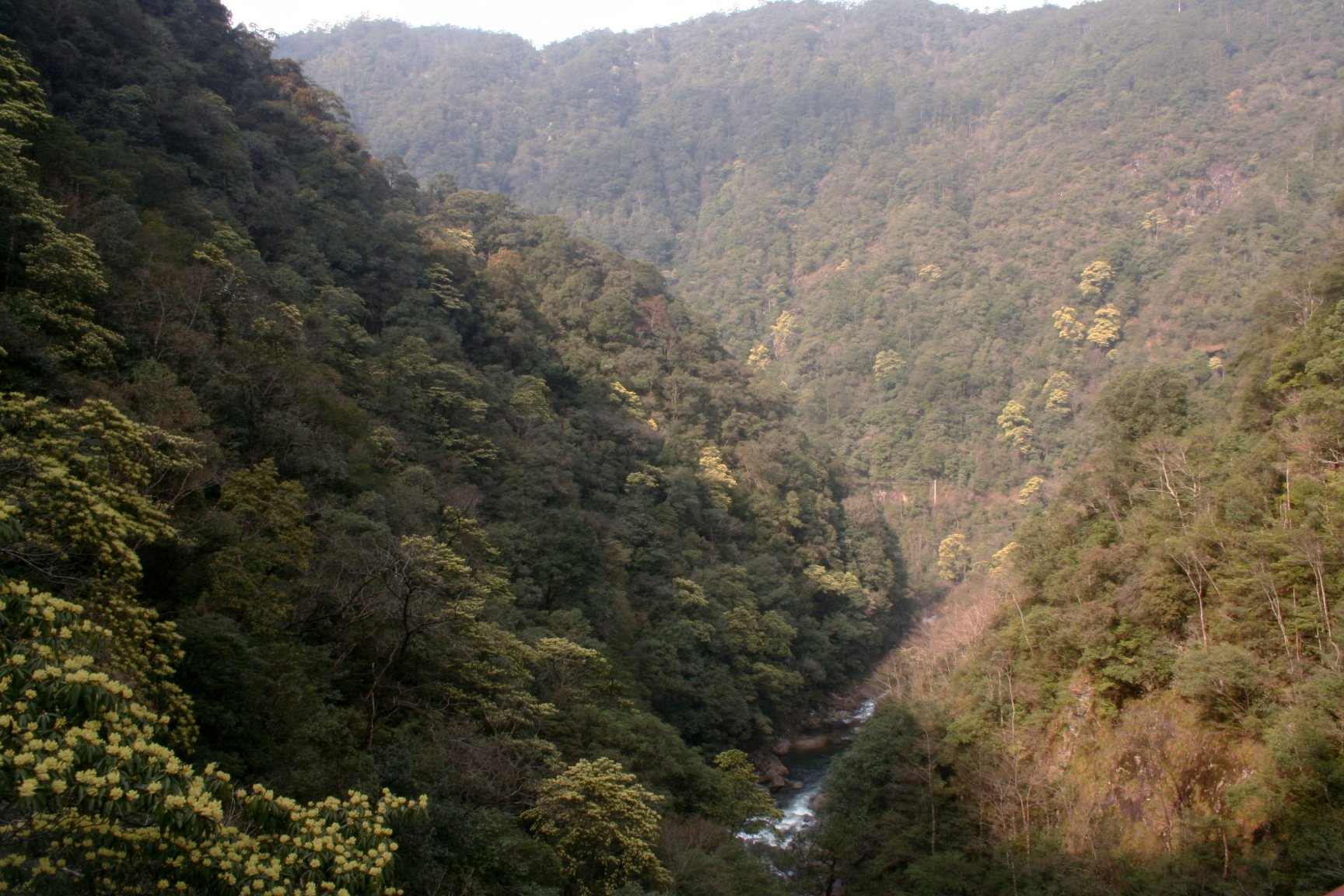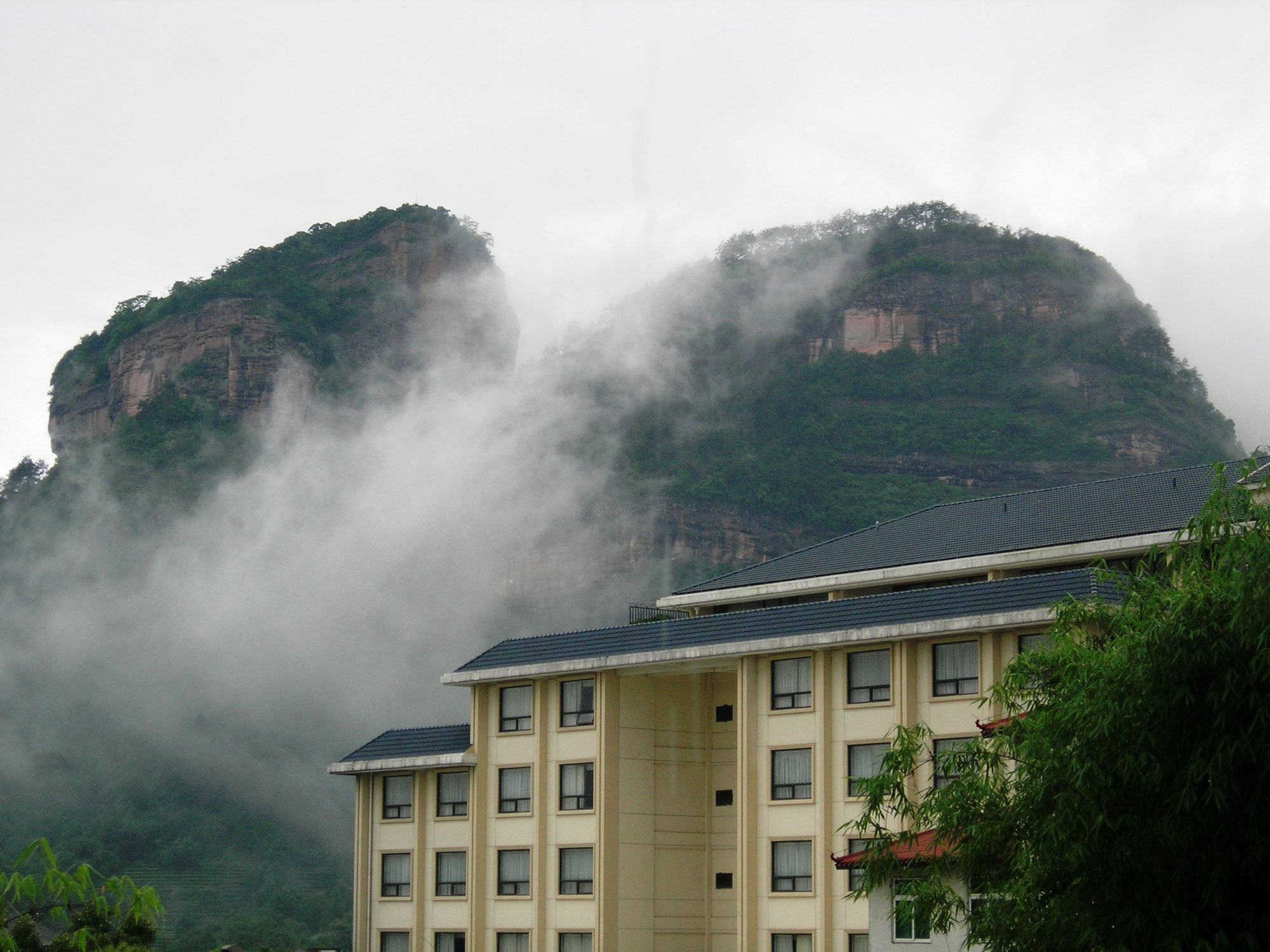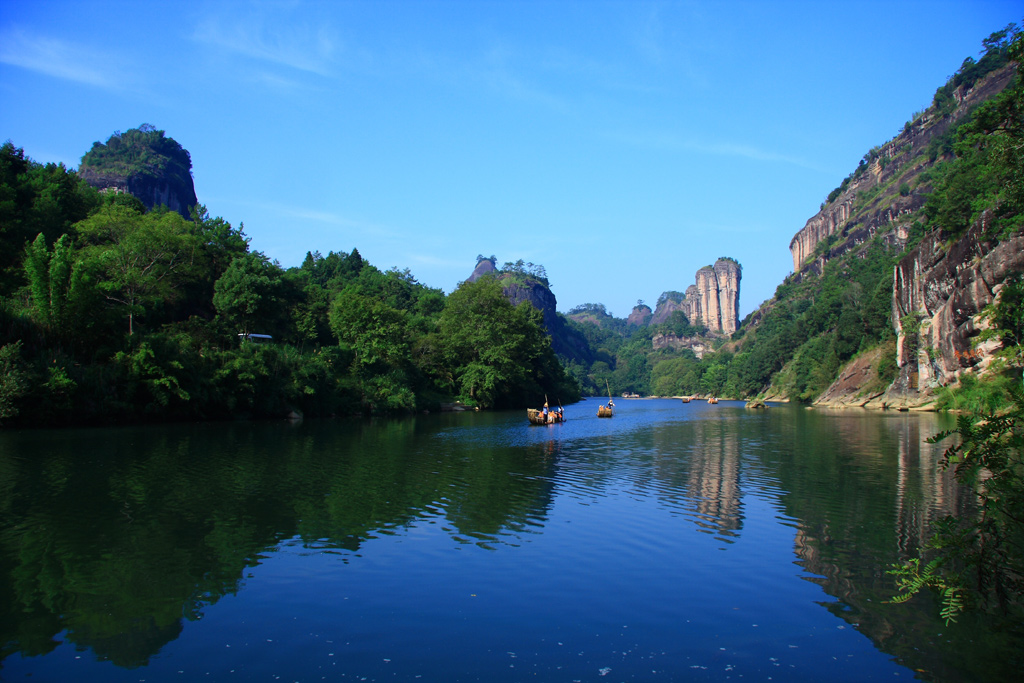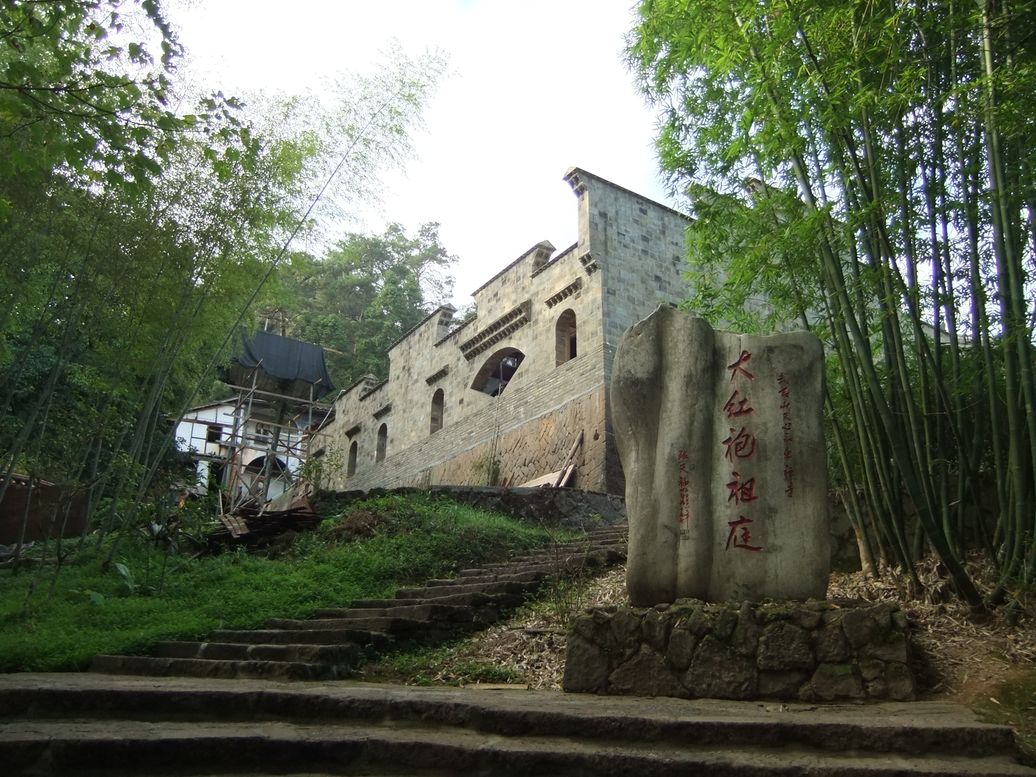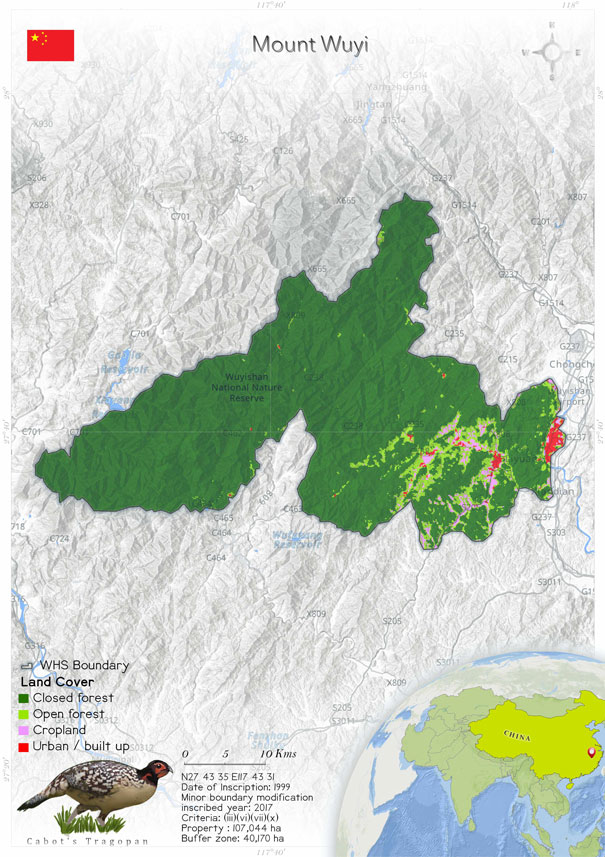
Mount Wuyi (911)
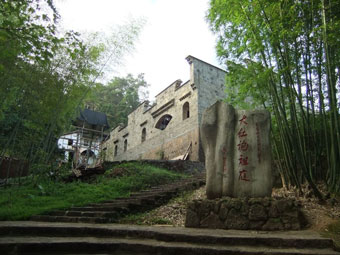 Mount Wuyi is situated in Fujian, a province in the south-east of China. It has diverse Chinese subtropical forests and the South Chinese Rainforest. Mount Wuyi is the most important expanse for biodiversity conservation in south-east China. It is also home to a good number of ancient relict species that are mostly endemic to the country. The site consists of four protected areas: Wuyishan National Nature Reserve, in the west, Nine-Bend Stream Ecological Protected Area, in the centre, the adjoining Wuyishan National Scenic Area, in the east, and the separate Protection Area for the Remains of Ancient Han Dynasty, about 15 km to the south-east. The property spreads over a total area of 107,044 ha. There is a 40,170 ha buffer zone, which has cultural as well as scenic and biodiversity values. The site is controlled and managed by the Government of the People’s Republic of China. The site is characterized as a state-level nature reserve that is narratively linked with the scenic area, a forest park, and a state-level cultural relic to protect the unit. Hence, the integrated efforts have been successful of the cultural and natural values of the property that subsumes a large number of national laws including the Forest Law (1998), the Environment Protection Law (2002), Regulations on Nature Reserves (2002), Cultural Relics Protection Law (2002), the Law on the Protection of Wildlife (2004), and Scenic Areas Ordinance (2006).
Mount Wuyi is situated in Fujian, a province in the south-east of China. It has diverse Chinese subtropical forests and the South Chinese Rainforest. Mount Wuyi is the most important expanse for biodiversity conservation in south-east China. It is also home to a good number of ancient relict species that are mostly endemic to the country. The site consists of four protected areas: Wuyishan National Nature Reserve, in the west, Nine-Bend Stream Ecological Protected Area, in the centre, the adjoining Wuyishan National Scenic Area, in the east, and the separate Protection Area for the Remains of Ancient Han Dynasty, about 15 km to the south-east. The property spreads over a total area of 107,044 ha. There is a 40,170 ha buffer zone, which has cultural as well as scenic and biodiversity values. The site is controlled and managed by the Government of the People’s Republic of China. The site is characterized as a state-level nature reserve that is narratively linked with the scenic area, a forest park, and a state-level cultural relic to protect the unit. Hence, the integrated efforts have been successful of the cultural and natural values of the property that subsumes a large number of national laws including the Forest Law (1998), the Environment Protection Law (2002), Regulations on Nature Reserves (2002), Cultural Relics Protection Law (2002), the Law on the Protection of Wildlife (2004), and Scenic Areas Ordinance (2006).
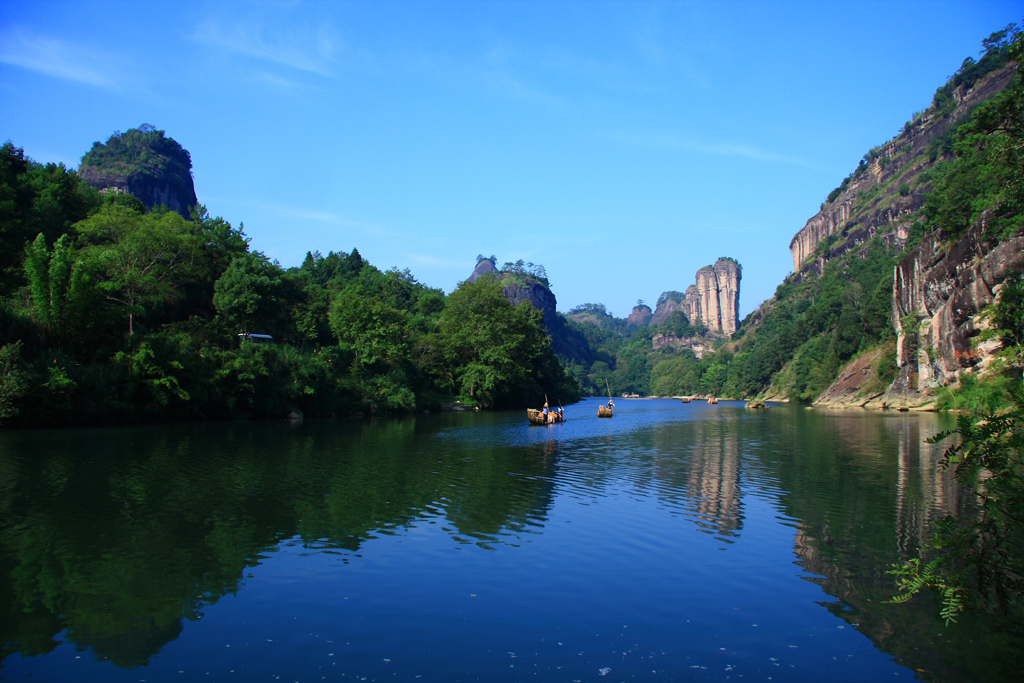 The site is recognized as crucial for conservation. The Nine-Bend River, with ruins of temples and monasteries, is of great archaeological importance. It has a large number of ancient relict plant species. Many of them are endemic to China. The fauna includes a number of reptile, amphibian and insect species. The site has a long history of biological research. There has been a recent notable discovery of a new amphibian species (Messenger et al. 2019). This is the first discovery of a new frog species in the region in after 50 years.
The site consists of four protected areas: Wuyishan National Nature Reserve, in the west, Nine-Bend Stream Ecological Protected Area, in the centre, the adjoining Wuyishan National Scenic Area, in the east, and the Protection Area for the Remains of Ancient Han Dynasty, about 15 km to the south-east. There are extensive swathes of Mao bamboo in the natural reserve section of the site. These pose a risk to the native vegetation and interrupts ecological processes and natural succession. A large number of tourists are attracted to the Nine-Bend Stream Scenic Area. This tourism poses a serious threat. Tea cultivation, bamboo production and the associated soil erosion affect the water and air quality seriously. At present, there is minimal tourism infrastructure development.
The site is recognized as crucial for conservation. The Nine-Bend River, with ruins of temples and monasteries, is of great archaeological importance. It has a large number of ancient relict plant species. Many of them are endemic to China. The fauna includes a number of reptile, amphibian and insect species. The site has a long history of biological research. There has been a recent notable discovery of a new amphibian species (Messenger et al. 2019). This is the first discovery of a new frog species in the region in after 50 years.
The site consists of four protected areas: Wuyishan National Nature Reserve, in the west, Nine-Bend Stream Ecological Protected Area, in the centre, the adjoining Wuyishan National Scenic Area, in the east, and the Protection Area for the Remains of Ancient Han Dynasty, about 15 km to the south-east. There are extensive swathes of Mao bamboo in the natural reserve section of the site. These pose a risk to the native vegetation and interrupts ecological processes and natural succession. A large number of tourists are attracted to the Nine-Bend Stream Scenic Area. This tourism poses a serious threat. Tea cultivation, bamboo production and the associated soil erosion affect the water and air quality seriously. At present, there is minimal tourism infrastructure development.
Criterion (iii)
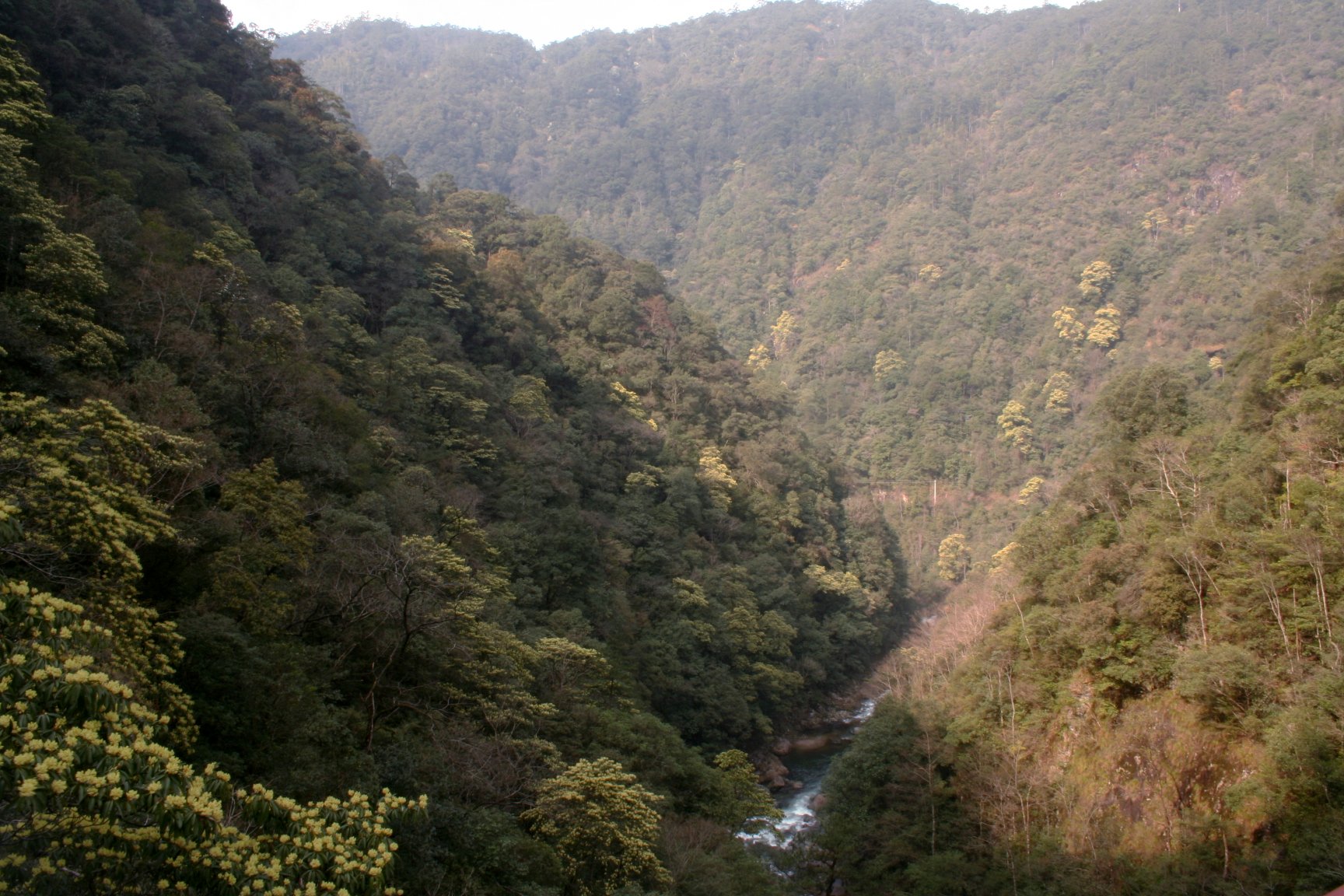 Mount Wuyi is a landscape of great beauty that has been protected for more than twelve centuries. It contains a series of exceptional archaeological sites, including the Han City established in the 1st century BCE and a number of temples and study centres associated with the birth of Neo-Confucianism in the 11th century CE.
Mount Wuyi is a landscape of great beauty that has been protected for more than twelve centuries. It contains a series of exceptional archaeological sites, including the Han City established in the 1st century BCE and a number of temples and study centres associated with the birth of Neo-Confucianism in the 11th century CE.
Criterion (vi)
Mount Wuyi was the cradle of Neo-Confucianism, a doctrine that played a dominant role in the countries of Eastern and South-eastern Asia for many centuries and influenced philosophy and government over much of the world.
Criterion (vii)
The spectacular landforms in the eastern scenic area around Nine-Bend Stream (lower gorge) are of exceptional scenic quality, with isolated, sheer-sided monoliths of the local red sandstone. They dominate the skyline for a tortuous 10 km section of the river, standing 200-400 m above the riverbed, and terminate in clear, deep water. The ancient cliff tracks are an important dimension of the site, allowing the visitor to get a ‘bird’seye- view’ of the river.
Criterion (viii)
China Danxia contains a wide variety of well developed red-beds landforms such as peaks, towers, mesas, cuestas, cliffs, valleys, caves and arches. Being shaped by both endogenous forces (including uplift) and exogenous forces (including weathering and erosion), China Danxia provides a range of different aspects of the phenomenon of physical landscape developed from continental (terrestrial) reddish conglomerate and sandstone in a warm, humid monsoon climate, illustrating both the range of landforms in relation to the forces and processes that formed them. The component parts represent the best examples of "least eroded" to "most eroded" Danxia landforms, displaying a clear landform sequence from "young" through "mature" to "old age", and with each component site displaying characteristic geomorphologic features of a given stage.
Status
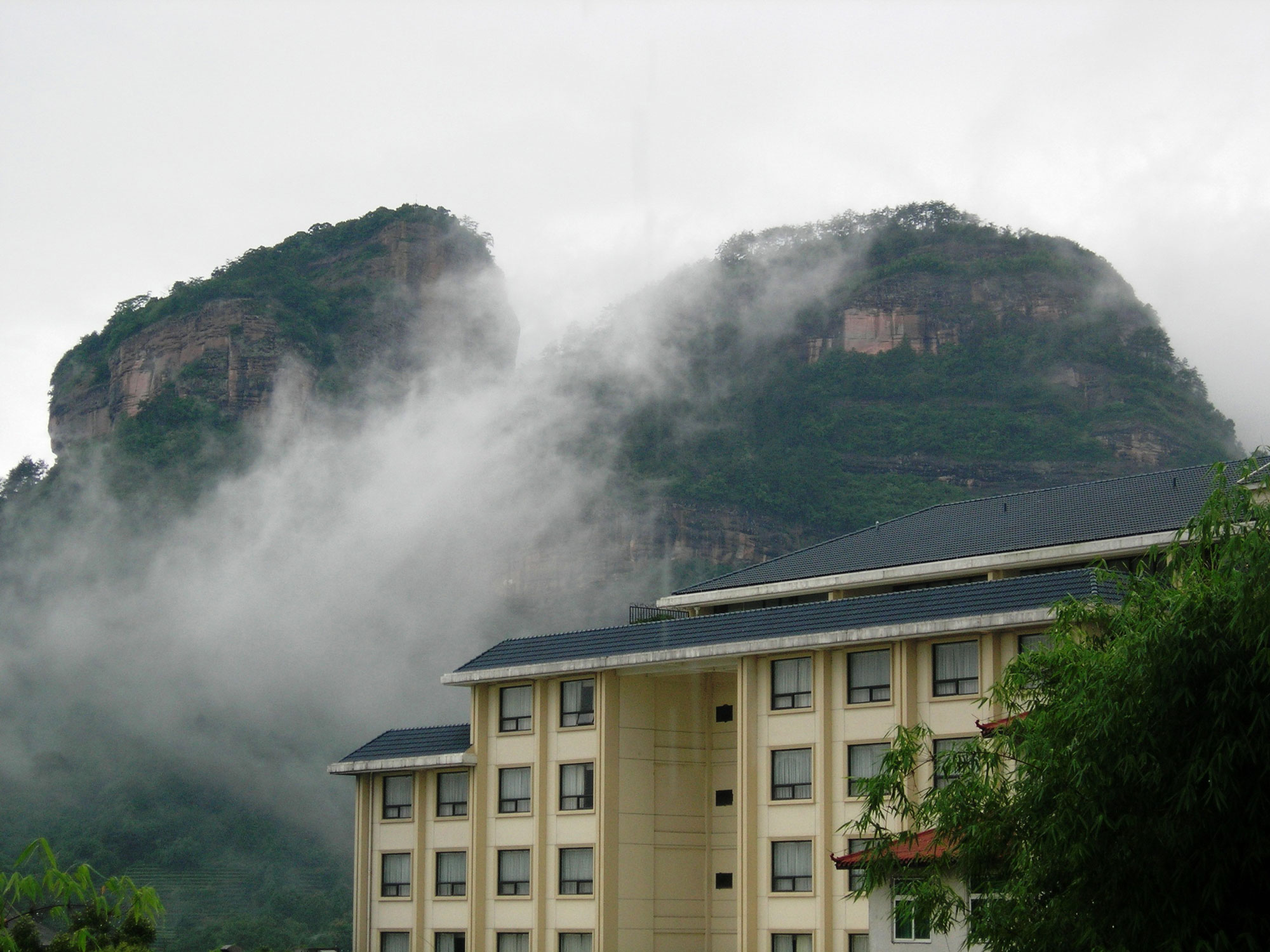 The site is controlled and managed by the Government of the People’s Republic of China. The site is characterized as a state-level nature reserve that is narratively linked with the scenic area, a forest park and a state-level cultural relic to protect the unit. Several regulations have been brought in with regard to Mount Wuyi by the National Government, in 1982, 1988, 1990, 1995, and 1996. The applicable national laws include the Forest Law (1998), the Environment Protection Law (2002), Regulations on Nature Reserves (2002), Cultural Relics Protection Law (2002), the Law on the Protection of Wildlife (2004) and Scenic Areas Ordinance (2006). Considering its international and national protection status, the property was earmarked as the UNESCO (MAB) Biosphere Reserve in 1987. Fujian Province has spread the protection of Mount Wuyi World Cultural and Natural Heritage and other important local regulations presented for the protection of Mount Wuyi as a World Heritage property. Extensive swathes of Mao bamboo in the natural reserve section of the site that pose a risk to the native vegetation, ecological audit processes and natural succession, mass tourism to the scenic Nine-Bend Stream area, tea cultivation and bamboo production are the threats to the site. The latter two cause soil erosion, with a heavy impact on the water quality and pollute the air. A less serious threat is posed by soil erosion from various sources, including tea cultivation, water pollution (sewage) and solid waste production (State Party of China 1998; World Heritage Committee 2012 WCMC2011). Moreover, the protected area (China) reforms such as national park authorities have been associated with the local government for efficient protection and management of Jiuqu Stream (IUCN Consultation, 2020). According to the records, there were 2400 residents in 2012, many of whom relied on subsistence forestry (bamboo). The managed Mao bamboo site has replaced the natural forestry region in most of the site. The growing of tea has led to soil and water quality deterioration due to agricultural run-off (State Party of China, 1998; World Heritage Committee 2012; WCMC 2011; IUCN 2006; State Party of China 2017a). Subsequently, efforts have been initiated to avoid the large-scale use of chemical fertilizers by embracing organic alternatives. This has reduced the harmful run-off significantly. Efficient management interventions and programmes such as Returning Tea to Forest (afforestation) have played a critical role in stabilizing forested areas (IUCN Consultation 2020). The site’s boundary has been modified to protect Jiangxi Province with the number of residents present in the buffer zone. Infrastructure development is taking place within the buffer zone, where catastrophic events such as cold-weather snaps and typhoon-associated floods (in summer) pose threats to the subtropical forests of the site. Their harmful impacts have affected migratory birds and the vegetation zonation. Several birds have been displaced to more northerly locations or higher altitudes, and the nominate race of the red-tailed laughing thrush (Trochalopteron milnei) appears to have disappeared (Fen-Qi et al. 2015). National parks of the Chinese protected area system form approximately 80% of the World Heritage Site (IUCN Consultation 2020). The World Heritage property is situated within strict protection zones where the implementation measures are strengthened in the presence of the Wuyishan Municipal Government for the protection of the property through administrative means, including “Qingshan Redemption”, which refers to the purchase and protection of commercial forests in crucial ecological locations (IUCN Consultation 2020). Mount Wuyi Jiangxi is provided with stable funding (State Party of China 2017).
The site is controlled and managed by the Government of the People’s Republic of China. The site is characterized as a state-level nature reserve that is narratively linked with the scenic area, a forest park and a state-level cultural relic to protect the unit. Several regulations have been brought in with regard to Mount Wuyi by the National Government, in 1982, 1988, 1990, 1995, and 1996. The applicable national laws include the Forest Law (1998), the Environment Protection Law (2002), Regulations on Nature Reserves (2002), Cultural Relics Protection Law (2002), the Law on the Protection of Wildlife (2004) and Scenic Areas Ordinance (2006). Considering its international and national protection status, the property was earmarked as the UNESCO (MAB) Biosphere Reserve in 1987. Fujian Province has spread the protection of Mount Wuyi World Cultural and Natural Heritage and other important local regulations presented for the protection of Mount Wuyi as a World Heritage property. Extensive swathes of Mao bamboo in the natural reserve section of the site that pose a risk to the native vegetation, ecological audit processes and natural succession, mass tourism to the scenic Nine-Bend Stream area, tea cultivation and bamboo production are the threats to the site. The latter two cause soil erosion, with a heavy impact on the water quality and pollute the air. A less serious threat is posed by soil erosion from various sources, including tea cultivation, water pollution (sewage) and solid waste production (State Party of China 1998; World Heritage Committee 2012 WCMC2011). Moreover, the protected area (China) reforms such as national park authorities have been associated with the local government for efficient protection and management of Jiuqu Stream (IUCN Consultation, 2020). According to the records, there were 2400 residents in 2012, many of whom relied on subsistence forestry (bamboo). The managed Mao bamboo site has replaced the natural forestry region in most of the site. The growing of tea has led to soil and water quality deterioration due to agricultural run-off (State Party of China, 1998; World Heritage Committee 2012; WCMC 2011; IUCN 2006; State Party of China 2017a). Subsequently, efforts have been initiated to avoid the large-scale use of chemical fertilizers by embracing organic alternatives. This has reduced the harmful run-off significantly. Efficient management interventions and programmes such as Returning Tea to Forest (afforestation) have played a critical role in stabilizing forested areas (IUCN Consultation 2020). The site’s boundary has been modified to protect Jiangxi Province with the number of residents present in the buffer zone. Infrastructure development is taking place within the buffer zone, where catastrophic events such as cold-weather snaps and typhoon-associated floods (in summer) pose threats to the subtropical forests of the site. Their harmful impacts have affected migratory birds and the vegetation zonation. Several birds have been displaced to more northerly locations or higher altitudes, and the nominate race of the red-tailed laughing thrush (Trochalopteron milnei) appears to have disappeared (Fen-Qi et al. 2015). National parks of the Chinese protected area system form approximately 80% of the World Heritage Site (IUCN Consultation 2020). The World Heritage property is situated within strict protection zones where the implementation measures are strengthened in the presence of the Wuyishan Municipal Government for the protection of the property through administrative means, including “Qingshan Redemption”, which refers to the purchase and protection of commercial forests in crucial ecological locations (IUCN Consultation 2020). Mount Wuyi Jiangxi is provided with stable funding (State Party of China 2017).
